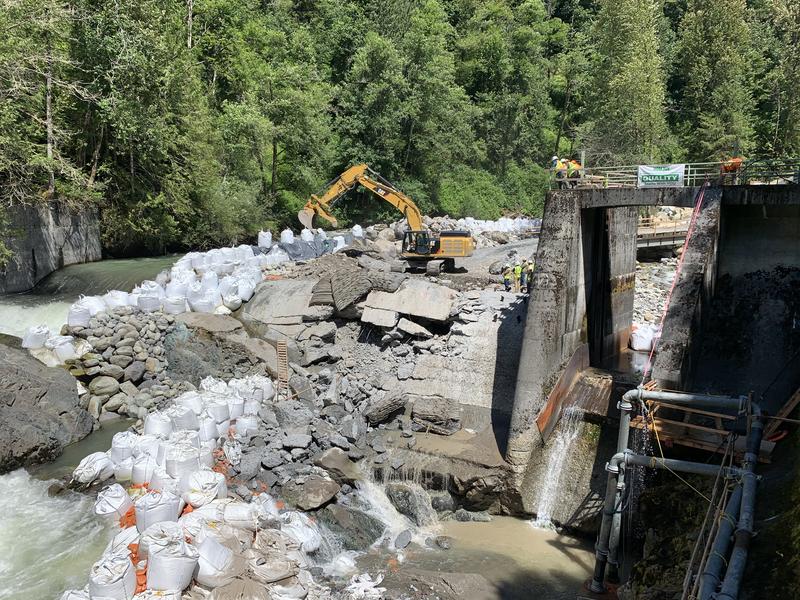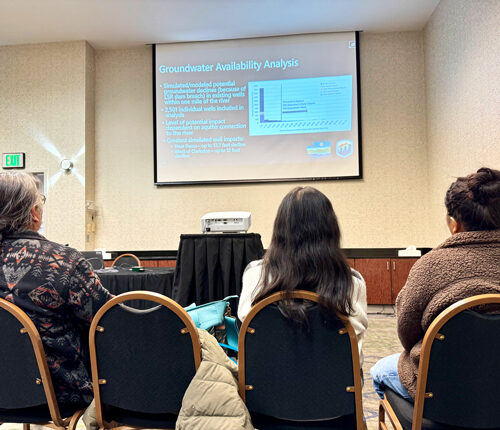
In Northwestern Washington, A Free-Flowing Middle Fork Nooksack River Is Just Months Away
READ ON
BY BELLAMY PAILTHORP / KNKX
A dam removal that has been 20 years in the making reached an important milestone this week. Explosives ripped through the concrete on the Middle Fork Nooksack, east of Bellingham.
A video captured the scene in the lush river valley between Mount Baker and Twin Sisters in the North Cascades: concrete flying from the top half of a 24-foot dam wall. Project supporters and participants said they watched it repeatedly, filled with delight and anticipation of what the demolition will bring.
“It’s wonderful to see years and years and years of hard work pay off, and the blast is the first real step in bringing this river back to life,” said Amy Kober, vice president of communications with American Rivers, which coordinated the project.
The dam was built in the early 1960s with no fish passage. It’s still used to supplement the city of Bellingham’s water supply.
“But we got creative. They’re moving the diversion upstream, so the city still has its great, sustainable water supply. And we get a free flowing river,” Kober says.
“And I just think that that is a lesson that we can apply to other rivers across our region. You can meet multiple needs if you work together.”
After years of efforts and aspiration, a grant from the Paul Allen Family Foundation provided the critical seed money that allowed the $20-million project to finally get going, says Renee LaCroix, Assistant Public Works Director and head of the Natural Resources Division at the City of Bellingham.
“We’ve been aware that this has been a fish passage problem for a long time and have been actively working to figure out a way to remove the dam or add fish passage to it for the last 15 years,” LaCroix says. “We’re really excited to see it come down.”
This video shows the first blast in the demolition process on Monday, July 13th, 2020. [Credit: Shane Anderson.]
There’s no shortage of outdated dams in the region that block fish passage and are candidates for demolition. But this one offered the prospect of exceptional habitat. The Middle Fork Nooksack is located is a remote valley with 16 miles of clean, cool water above the dam that will provide pristine habitat for several species of fish, including endangered Puget Sound runs of bull trout, steelhead and Chinook, which are the preferred prey for endangered Southern Resident Orcas.
Restoring this river carries with it the hopes of boosting all of those populations in a significant way.
Tribes in the area say the dam has also disrupted their access to a culturally significant area, ever since its construction began nearly 60 years ago. The Nooksack Indian Tribe and the Lummi Nation have been important partners and advocates for the dam removal project.
“It’s a very spiritual place. It’s a very culturally sensitive area for Nooksack,” says Trevor Delgado, the Historic Preservation Officer with the Nooksack Indian Tribe.
He says their ancestors often gathered in the valley near the dam site and stayed for days, hunting, gathering and engaging in ceremonies.
“So, we want to do everything that we can to make sure that it gets the protection that it deserves.”
He says the dam removal is an important aspect of cultural restoration.
The city of Bellingham is working with the Nooksack to install a marker at the site, conveying the cultural significance of the site, which Delgado says the tribe is also working to have put on the National Registry for Historic Preservation. The Middle Fork Nooksack River valley is known to the Nooksack people as Nuxwt’iqw’em (pronounced roughly, noo-TEEK-whum.)
The demolition work on the dam site will continue all summer. A completely free-flowing river is expected in late August or September, with hopes of returning fish runs this fall.
Copyright 2020 KNKX. To see more, visit knkx.org
Related Stories:

Snake River water, recreation studies look at the river’s future
People listen to an introductory presentation on the water supply study findings at an open house-style meeting in Pasco. After they listened to the presentation, they could look at posters

PNW artists’ work evokes salmon to educate, inspire change
Northwest artists have drawn inspiration from salmon as long as people have walked along the running streams. But, the movement to close four dams on the lower Snake River has some artists, activists and naturalists hopeful that their pieces will not only tug at heartstrings, but also move forward the conversation of salmon conservation and restoration.
Washington Gov. Jay Inslee recently signed budget bills to study removal of the four dams. Activists have been calling for the dam removals in order to preserve and restore salmon populations.

White River celebration: 11 years after dam removal, the river recovers
Miss Yakama Nation Ellia-Lee Jim and Jr Miss Yakama Nation-Tehya Listen Eleven years after the Condit Dam was removed from the White Salmon River, the fish (and the land) are















